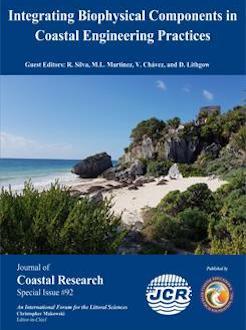Rodríguez-Gómez, C.F.; Aké-Castillo, J.A., and Vázquez, G., 2019. Short-term responses of the bloom-forming dinoflagellate Peridinium quadridentatum in tropical coastal waters: Environmental variables and phytoplankton community. In: Silva, R.; Martínez, M.L.; Chávez, V., and Lithgow, D. (eds.), Integrating Biophysical Components in Coastal Engineering Practices. Journal of Coastal Research, Special Issue No. 92, pp. 22–32. Coconut Creek (Florida), ISSN 0749-0208.
Peridinium quadridentatum (F. Stein) Hansen is a common dinoflagellate in tropical and subtropical areas worldwide that produces harmful algal blooms (HABs), mostly during the rainy season. This study aimed at identifying the short-term variations in the density of P. quadridentatum and the formation of blooms in relation to the environmental variability of physicochemical and phytoplankton parameters. Sampling and in-situ data collection were conducted at the surface of the water column during daytime and nycthemeral cycles in the rainy season at a fixed station located to the southwest of the Gulf of Mexico during 2017 and 2018. During P. quadridentatum blooms (>1x106 cells L-1), significantly higher temperatures (>31°C) and dissolved oxygen (DO) concentrations (6.5 mg L-1), as well as significantly lower ammonia, nitrate and phosphate levels (1.4, 0.9 and 0.01 μM, respectively) were recorded compared to normal conditions. The hourly analysis revealed that, the cell density of P. quadridentatum increases during the morning to reach peak levels at 16: 00 h in sunny days, conferring a reddish-brown color to water, followed by an abrupt drop in density in the nighttime-early morning, to start a new cycle the following day. Other HAB-forming species also decreased in density when P. quadridentatum HABs occur. High temperatures during rainy season favor the formation of HABs of P. quadridentatum. Although in the rainy season occurs high concentration of nutrients, the HABs of P. quadridentatum appear when there is a decrease in that concentration. Peridinium quadridentatum seems to be a less effective competitor compared to diatoms that form blooms in high nutrient concentrations. Long-term monitoring of nutrient concentrations in river basins and areas close the wastewater treatment plants is suggested to be aware of development of HABs.





